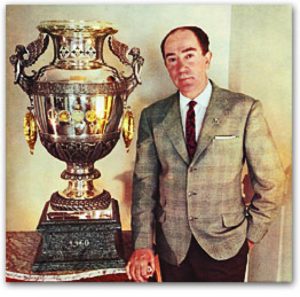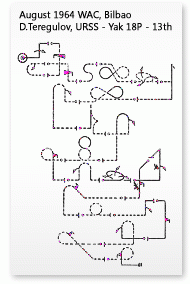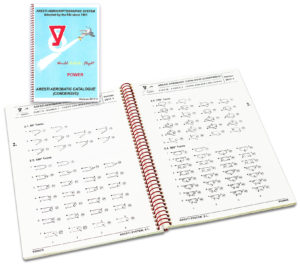The 'Aerocryptographic Sistema Aresti'
 The Sistema Aresti Dictionary of aerobatic figures created and developed by José Luis Aresti Aguirre, a leading Spanish aerobatic pilot, was first published in 1961. It provided the foundation for the Aresti Catalogue (Condensed) that we use today.
The Sistema Aresti Dictionary of aerobatic figures created and developed by José Luis Aresti Aguirre, a leading Spanish aerobatic pilot, was first published in 1961. It provided the foundation for the Aresti Catalogue (Condensed) that we use today.
Before this time there was little standardisation in the notation systems that pilots used to describe the figures that they would fly, and consequently judging interpretation and technique could vary widely from one judge - and one event - to another. Initially the Sistema Aresti Dictionary depicted some 3,000 figures, each with their own difficulty coefficient, and over time this number inevitably increased. By the 1964 Third FAI World Aerobatic Championship in Bilbao however CIVA had introduced an improved and simplified grading system, and this forms the basis for the structure that we all use in the second decade of the 20th century.
The Aresti Cup, donated by Col. Jose L. Aresti of Spain to the FAI in the 1960's, is presented to the World Aerobatic Champion. The trophy was first presented in 1964 to Tomas Castano of Spain. Not only the most prestigious award given in competition, the Aresti Cup is also truly a work of art - created in silver with gold embellishments and featuring gold coins around its diameter symbolizing member nations of the Fédération Aéronautique Internationale. The trophy is topped with a golden globe that featured Col. Aresti's favorite aircraft, the Bücker Jungmeister, but which has now been lost to time. The names of past Champions are engraved around the base of the trophy.
Aresti System families of Figures
Aerobatic figures were initially divided into nine families, the first eight of which provided the 'base' figures onto which the aileron rolls of family-9 could be superimposed to create composite figures. Family-4 originally provided all of the possible variations of spins, but the later adoption of a wider range of base figures that could all have spins added to them led to this family becoming unused and the spin elements are now included in roll family-9. A logical approach to determining the difficulty coefficient of the whole figure was also introduced.


The Aresti Catalogue (Condensed)
The catalogue of figures that we use today is developed in response to updates and additions approved each year by the CIVA plenary, and now the Aresti Catalogue (Condensed) is produced and distributed solely by Aresti System S.L. in Spain.
CIVA also runs an Aresti Committee in conjunction with representatives of the Aresti family, to ensure the smooth adoption of new ideas and figure elements that underpin the increasing range of international championship categories that CIVA supports.
The Aresti Catalogue (Condensed) is available from Aresti System S.L. in both Power and Glider versions, along with alternatives that are used by the aerobatic modelling community and others.
- You can visit the Aresti website using this link:
 Aresti System S.L.
Aresti System S.L. - The online Wikipedia free encyclopedia also has a useful:
 Aresti Catalogue page
Aresti Catalogue page
